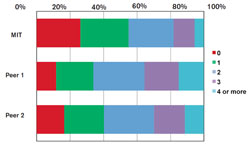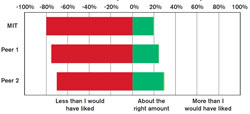
| Vol.
XXV No.
4 March / April 2013 |
| contents |
| Printable Version |
MIT Freshman Mentoring and Advising:
The Role of the Faculty
As a mentor, a faculty member becomes an essential part of the network that supports freshmen during their transition from high school to university life. Faculty mentors provide excellent support for the development of individuals who will become lifelong learners and leaders. Faculty mentors also provide counsel on the intellectual and disciplinary paths to follow while enrolled at MIT and on directions to pursue after graduation. Faculty mentors facilitate future opportunities by providing letters of recommendation for summer jobs, internships, or graduate school applications. Faculty involvement and interaction with freshmen leads to better teaching and learning and is a natural mechanism for improving the quality of residence-based undergraduate education.
Freshman advising at MIT has been a topic of concern over the past decade because of the decline in the number of faculty members serving as freshman advisors. The number has decreased from a high of ~120 faculty in 1996 to only 83 in the current academic year.
Consideration of how MIT might reverse this decline in faculty involvement led the Committee on the Undergraduate Program (CUP) to evaluate the key principles underlying the current freshman advising model.
In the course of this exercise the CUP developed a set of desired characteristics for MIT’s freshman advising program. An important finding of CUP’s study was that faculty are only one part of an advising and mentoring network, but they are an essential part. The CUP believes that this knowledge and recent developments in support for freshmen at MIT, described below, provide new opportunities for more faculty members to become involved in freshman mentoring.
Reassessing Residence-Based Education
This is a critical time for MIT’s faculty to reassess its vision of residence-based education. Part of that re-evaluation must consider the role of faculty/student mentoring. The CUP believes that intellectual interactions between faculty and students should be a core value and defining characteristic of an MIT undergraduate education. The 2011 Enrolled Student Survey found that MIT undergraduates were significantly less satisfied with the amount of faculty interaction than students at the institutions represented in two cohorts of peers: Peer 1, a small group of private, highly-selective research universities with whom we most closely identify; and Peer 2, a larger group of other private, highly-selective research universities.
Furthermore, the same survey also revealed that MIT seniors are much less likely than students at those peer institutions to know three or more faculty members who would write letters of recommendation. This finding has serious implications for our students’ post-baccalaureate planning.

(click on image to enlarge)
MIT students want more interaction with faculty members and one important way to meet this desire is to provide faculty mentoring during the freshman year, and to continue it through a student’s time at MIT. The CUP believes that the current model for faculty engagement in freshman advising can be improved upon. It should be possible to structure the program so that the faculty advisor’s efforts are focused on mentoring more than on subject selection and other administrative activities.
| Back to top |
In the past, freshman advising has required faculty advisors to know “everything” about MIT’s freshman year – or at least that is what many faculty members have assumed. In reality, there has been a significant shift from that time-consuming and sometimes emotionally demanding role to one in which the faculty member is part of a freshman’s network of support. This network includes knowledgeable staff with expertise in degree requirements, professional development, and support of the physical and mental well-being of our students. Many members of the academic community, in addition to faculty members, already contribute to this suite of resources.
Academic Resources
- Advisor
- Student Associate Advisor
- Office of Undergraduate Advising and Academic Programming (UAAP)
- Academic program offices (e.g., Communication and HASS Requirements)
- ROTC officers
- Learning communities – Concourse, Experimental Studies Group (ESG), Media Arts and Sciences (MAS), and Terrascope
- Office of Minority Education (OME)
- UROP supervisors
Residential Resources
- Housemasters
- Graduate Resident Tutors (GRT)
- Residential Life staff
Other Professional Resources
- Coaches
- Office of Global Education and Career Development
- Student Support Services
The specific roles and responsibilities for each group within the advising and mentoring network have been discussed by the CUP, DUE, and staff in the UAAP, the office that coordinates freshman advising. These groups worked together to define a matrix of the interconnected and interrelated roles for the members of the network. For some types of advice, the faculty mentor plays a key role; while for other types of advice the student associate advisor or a housemaster plays the primary role.
Although existing resources available to freshmen are diverse, this network of support would benefit greatly from increased faculty involvement. The CUP’s goal is to turn the existing advising/mentoring network into a system that encourages faculty commitment to freshman advising while shifting the faculty advisor’s primary role from one that is often largely administrative to one that is primarily focused on mentoring.
The key to this is structuring a system that takes advantage of the complementary skills and knowledge available from other teaching staff and administrators. Our proposal would initially build on the two existing avenues available now for faculty participation in freshman advising: offering a Freshman Advising Seminar (FAS) or participating in a traditional advising relationship. Every advisor will be matched with an upper class student, the Associate Advisor, who is well informed in the GIRs and is knowledgeable about MIT support resources.
Accomplishing Our Objectives
To accomplish our objective of ensuring that every first-year MIT undergraduate is advised or mentored by a faculty member, we need about 145 faculty mentors. That is about 12.5% of the number of full-time MIT faculty. Mentoring could be provided through Freshman Advising Seminars, traditional advising, and by faculty pairing up with staff advising experts in UAAP, ESG, Concourse and OME. And we should think about new ways of mentoring students. Meeting regularly with a small group of students for lunch or dinner could be a very effective and enjoyable way of interacting. Yale University does this in their system of residential colleges. Faculty members have an open invitation to dine with undergraduates. If you have visited Yale and experienced the intense and vibrant exchanges that go on at almost every dining table, you probably thought “Why don’t we do this at MIT?”
Why haven’t we met this goal of freshman mentoring before now? In the past two decades, a number of faculty-led committees have looked at freshman advising and made suggestions on how we could enhance faculty participation. The CUP spent the past year developing a set of Freshman Advising Principles. A review of the “Report of the Task Force on the Undergraduate Educational Commons” also provided some sound and thoughtful advice on this subject.
One reason that things have not changed relates to the fact that some faculty in departments with large undergraduate enrollments are already advising sizeable groups of upper-class undergraduates, which can consume a great deal of faculty time and energy. There is a feeling that there is not enough time for faculty to do freshman advising as well. However, not every department has a large number of majors, and we could distribute mentoring activities in a way that shares the load among us all. Also, we don’t need to have every faculty member in the Institute participating in freshman advising. As outlined above, this problem could be solved if we increase the number serving as freshman advisors from 70 to 145. An additional 75 faculty advisors should be sufficient.
Can we not find a way to do this? Perhaps it is time to provide some incentives or look at the advising load of departments and balance these loads by distributing responsibilities for freshmen to faculty in departments with smaller undergraduate enrollments. Perhaps we can identify and provide meaningful incentives. In any case, it will require that all of us at MIT – faculty members, department heads, deans and the MIT administration – work together to create a new system to mentor first-year students. We will need to identify resources and develop mechanisms that support faculty mentoring and advising. To begin this process of reinventing freshman advising at MIT, the CUP offers the following resolution:
Proposed Faculty Resolution
It is the sense of the MIT faculty that every freshman should have a faculty member serving as a mentor or advisor. We ask that the leaders in MIT’s administration partner with the CUP, the Deans of the five Schools, and DUE and DSL to develop and implement an advising program that moves us towards this end.
We would value your input, advice, and feedback on this proposed faculty resolution.
Click here for the student's perspective on the Proposed Faculty Resolution.
| Back to top | |
| Send your comments |
| home this issue archives editorial board contact us faculty website |
